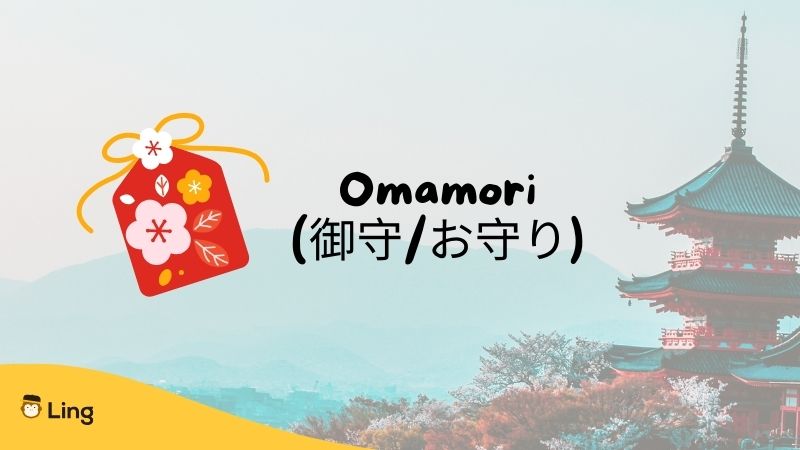Wondering what a Japanese Omamori is? I was just like you back then!
Soon after I touched down in Tokyo, I started noticing little colorful pouches dangling everywhere. From backpacks to rearview mirrors to shrine altars, these satin bags popped up on every block. Locals gently jingled the embroidered satchels while making wishes at temples. Taxi drivers clutched them as they navigated jam-packed streets. What gave these ornate little bags such power and presence?
I’m no stranger to good luck trinkets from my globe-trotting days, but nothing intrigued me more than the omamori charms that seemed to hold such meaning across Japan. Whenever I asked about the embroidered talismans, my new Tokyo friends and colleagues would rave about the blessings, safety, and fortune they bring.
So in this blog, I’ll provide the ultimate insider perspective to demystify the #1 most important Japanese good luck charm – the omamori charms! I’ll also let you in on some useful Japanese phrases related to these Japanese amulets. Let’s begin!
Table of Contents

What Is Japanese Omamori (御守/お守り)?
So what exactly are these captivating little pouches that grabbed my curiosity across Tokyo? 御守/お守り or omamori (o-ma-mor-ee) literally translates to “honorable protection” or personal amulet. And they live up to the name! These silk charms are blessed by monks and priests to safeguard owners from harm or misfortune.
Basically, these protective amulets originated from both Shinto and Buddhist traditions that date back centuries. The concept combines supernatural magic with faith; they contain prayers or blessings within a tiny cloth pouch typically made of intricately embroidered silk or brocade. Many are also decorated with intricate details, symbolic imagery, and kanji characters invoking various fortunes.
So where exactly should you keep these blessed charms once you get one? Traditionally people carry them in handbags, display them in entry altars, or even keep them in cars as they commute. Part of the omamori’s power comes from keeping their bless-filled energy physically close!
What Does A Japanese Omamori Look Like?
For carrying such lofty protective blessings, omamori pouches have a surprisingly humble and uniform design. But don’t let the petite size fool you – big fortune comes in small satin packages!
Most omamori are about the size of a business card, with a regimented fringe of silk tassels dancing along the bottom. The actual pouch uses sheeny fabrics like silk brocade or polished satin, bursting in lucky red, gold, yellow, green and blue hues. After all, when supernatural magic dwells inside, only the brightest colors will do!
Keep an eye out, and you’ll notice delicate kanji stitched into the fabric itself, denoting what aspect of fortune the omamori invokes. Some promise academic success, while others ensure road safety or prosperity. Specialty versions shine even brighter too.
During festivals and celebrations, artisan omamori makers showcase elaborate designs fit for royalty – shimmering golden phoenixes, dancing dragons, and Chinese zodiac symbols associated with the year. Even the simpler satchels reflect intricate craftsmanship though, with impossibly tiny calligraphy and abstract symbols woven intricately into the smooth fabrics.
How To Carry A Japanese Omamori?
Given an omamori’s protective nature, proper handling is key to unleashing its full power. But how exactly should you integrate these mystical pouches into your daily life?
Most omamori come with a thin rope or braided tassel attached to one end. This allows easy attachment to your belongings – loop it around your backpack straps, wallet zippers, purse handles, or belt loops. Pouches designed for traffic safety often feature suction cups to display inside cars. Smaller rectangle ones double nicely as phone straps.
No matter what you select, the omamori should remain on your person as much as possible. Legend says keeping its blessing close physically and spiritually connects you to its enchantment. This fuels the omamori to work its metaphorical magic shielding you from adversity!
Certain varieties have designated locations to optimize their fortune-giving. Relationship or family omamori traditionally rest near the bed to nurture intimacy or fertility. Students might keep academic success charms inside pencil cases or school bags to enhance concentration and wisdom. Even if you’re not superstitious, carrying it visibly sparks intriguing conversations!
@frennymari Japanese Amulets or lucky charm, Omamori in Japanese #omamori #japaneseamulets #luckycharm #japan #summerfestival #mantosaifestival
♬ original sound – Pamela Mari – Pamela Mari
What Are The Common Types Of Omamori Charms?
The most common omamori types invoke general good luck, so-called “shiawase (幸せ)” happiness charms promise to make your day brighter regardless of what mischief karma cooks up. Others attract love and marriage, earning them popularity with singles and romantic couples alike. Charming symbols like birds, hearts, or red ribbons denote these “en-musubi (縁結び)” pouches.
Students seek out “katsumori (勝守)” academic and success-themed omamori decorated with scholarly motifs. These tiny totems can focus the mind and manifest discipline through key exams. Drivers often adopt “kotsu-anzen (交通安全)” vehicle safety omamori displaying comforting roadway imagery. Their prayers guide you safely along perilous highways and congested streets.
Health concerns also have specialized omamori to bless vitality and harmony. Expect to see longevity symbols like cranes and turtles or the leafy ginkgo biloba tree in this variety. New parents may adopt “kanai-anzen (家内安全)” family safety pouches as well!
Other Good Luck Charms In Japanese Culture
While omamori rank among the most iconic, several other meaningful good luck charms permeate Japanese tradition. Here are some of our favorites:
- Maneki-Neko – Beckoning cat figurine with paw raised up to invite money and customers. Displayed in businesses and homes.
- Seven Lucky Gods Figurines – Figurines representing seven deities from mythology associated with different blessings. Commonly found in homes and gardens.
- Lucky Bamboo – Lucky bamboo plants are associated with prosperity and longevity.
- Rakan Statues – Stone statue heads representing the disciples of Buddha, used to ward off misfortune.
- Oni Demons – Red demon masks and figures placed over doorways to frighten away bad luck.

Japanese Phrases For Buying Your Lucky Charm
While it helps to know your omikuji paper fortune rituals, purchasing omamori proves more straightforward. Shops or booths selling these talismans typically display pricing charts denoting each kind. All the same, having key Japanese phrases in your back pocket smooths the transaction!
Here’s how to do it.
こんにちは (Konnichiwa)
Translation: “Hello” / “Good afternoon!”
When you walk into those adorable little shops, a bright “konnichiwa!” is the perfect way to greet the clerk and show you’re eager to browse their bounty of blessings.
これをください (Kore o kudasai)
Translation: “I’ll take this one, please”
And ooooh, how cute is that one with the tiny Tanuki figure! To politely signal you’d like to take it home, just point and say “kore o kudasai” – which means “I’ll take this one please.” Add in numbers if you’ve fallen for a few…I know I always walk out with a handful!
はい、わかりました (Hai, wakarimashita)
Translation: “Yes, I understand”
When it’s time to pay, the clerk will share the cost, and you can confirm with a “hai, wakarimashita” – “yes, I understand.” Smooth purchase complete!
ありがとうございます (Arigatō gozaimasu)
Translation: “Thank you very much”
Then, don’t forget to seal the deal with a genuine “arigatō gozaimasu” on your way out. It’s a graceful way to say “thank you very much” and express your gratitude for their service. I just love how thoughtful all these Japanese customs are, you know?
Banish Bad Luck Now With An Omamori
Oh I just love browsing through the omamori charms when I travel in Japan! Like will I go for the one with book symbols to connect with my inner bookworm? Or maybe I’ll be drawn to a charm embroidered with romantic kanji, promising new adventures in love! I let those cute patterns and prints speak to me in the moment. Choosing an omamori that sparks joy makes for such a special travel memento, you know?
And if you’re looking to keep soaking up some great Japanese phrases for your next trip, check out the Ling app. I’m obsessed – they make picking up a language so much fun and personalized to exactly where you’re headed. It’s perfect for unlocking Cool Japan vibes no matter where you roam! Plus, who doesn’t love a app that caters vocab and culture straight to YOUR interests? Game-changing if you really want to dive into the spirit of a place, and make local connections on an adventure. I can’t recommend it enough!


































































